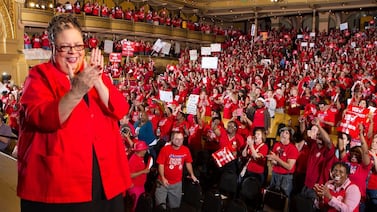The Illinois State Board of Education kicked off the process of crafting budget recommendations for the 2024-25 school year at the first of two virtual meetings Thursday night.
With the deadline to spend federal COVID relief money approaching, lobbyists, superintendents, school teachers, and advocates made the case for board members to ask Gov. J.B. Pritzker and the state legislature to beef up the education budget with at least a $550 million increase in what’s called “evidence-based funding” — a way of allocating additional state money that’s supposed to take into account student needs and lessen the disparity between districts that have affluent tax bases and those that don’t.
The state is supposed to increase evidence-based funding by $350 million each year with the goal of getting all school districts adequately funded by 2027. Lawmakers have done so every year since 2018, but the pandemic derailed one such increase in 2020. As a result, advocates argue that lawmakers need to boost that number to $550 million in order to meet the same funding level at a time of increasing costs for school districts and as federal pandemic relief dollars run out.
Chicago Public Schools already forecast a $628 million deficit by 2026, and district officials have called on the state to ramp up the amount of money it puts into K-12 education.
Vanessa Espinoza, a parent of three CPS students and a member of Kids First Chicago, a nonprofit advocacy group, argued that Illinois’ current education system shows deep disparities between affluent and low-income districts. But the quality of a public education “should not be determined by their zip code,” Espinoza said, advocating for the extra funding boost. “I have seen teachers struggling to make ends meet. You can make a profound difference in the lives of countless children and families across the state.”
The virtual meeting on Thursday evening was the second gathering this week, coming after ISBE held its first in-person meeting in Springfield. Christine Benson, chair of ISBE’s Finance and Audit Committee explained that testimony during the public hearings helps inform the budget recommendation it will make to the governor and state lawmakers in January 2024.
“We want to know what investments would make the biggest difference for the students and educators in each community,” said State Superintendent of Education Tony Sanders in a statement last month. “Advocacy matters and truly makes a difference in how state funds are allocated.”
Advocates at the hearing also called for funding boosts to early child education, after school programs, career and technical education programs, and agricultural programs in K-12 schools. Last year, Pritzker added $75 million to early childhood education as part of a four-year plan called Smart Start Illinois to expand preschool and child care. Some who spoke Thursday supported the continued increases.
In May, state lawmakers passed a $50.6 billion state budget that allocated $10.3 billion to education. That included a $350 million increase to be distributed to K-12 school districts through evidence-based funding.
Chicago was expecting to get $27 million of that increase. But new calculations posted on the Illinois State Board of Education website show that the state is allocating $23.3 million of the increase to CPS. The drop in Chicago’s share of new state education money is partly due to a loss of low-income students and an increased property tax base.
Although state education funding has been increasing since 2017, many argue that Illinois still has a long way to go to make school funding more equitable.
Diana Zaleski, a lobbyist for the Illinois Education Association, lauded efforts so far to close the gap between the wealthiest and poorest districts in the state.
“We still have more work to do,” Zaleski said, as she urged board members to recommend a roughly $800 million increase per year in evidence-based funding to meet state goals of bringing all districts to a level of “adequacy” that would dispel an old image of Illinois ranking toward the bottom of public education funding.
Jill Griffin, superintendent of the Bethalto School District about an hour’s drive south of Springfield, said she remembers a time when the district was facing “catastrophic cuts” with only 28 days of cash on hand “in large part because of inadequate funding from our state.”
Since Illinois adopted the evidence-based formula in 2017, Bethalto is at 71% adequacy and “back on solid financial footing,” Griffin said. But with more money going to minimum wage increases for school staff, higher wages for teachers, and other state mandates, “this progress is inadequate.”
ISBE will hold another virtual public budget hearing on Oct. 30.
Michael Gerstein is a freelance writer based in Chicago.







